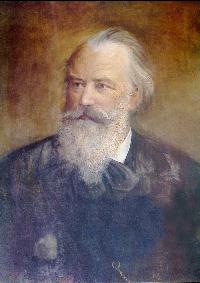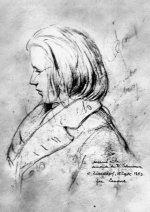
o

Brahms cdc 011 Real Audio: Variations Op. 56b on a theme by Haydn for two pianos (Tema, Andante) |
"A man of young blood has arrived who as a child was watched over by the graces and the heroes. His name is Johannes Brahms ... he has all the external signs which declare: here is one of the chosen!". Such were the words which Robert Schumann used to herald the young composer in the "New Musical Review". Johannes began his career playing for a mark and a half an evening in the taverns of the back-alleys of Hamburg. He was taken around by his father Johann Jakob, a musician of little talent whose dream was that his son would follow the same career! However, he soon realised that in that thin and slight little boy endowed with two imposing and enormous hands and great creativity there was something which was much more than mere talent. Luckily enough, he decided to entrust his son to more able and skilled hands. In time Johannes would reveal his |
 disappeared,
and believing that he was behind the times he sought to develop
a more up-to-date language which was free of the Romantic features
which had characterised his predecessors. This was something which
created marked problems of identity, and Brahms ended up by being
the most Classical of the Romantics.
disappeared,
and believing that he was behind the times he sought to develop
a more up-to-date language which was free of the Romantic features
which had characterised his predecessors. This was something which
created marked problems of identity, and Brahms ended up by being
the most Classical of the Romantics. Chronology:
| 1833 | Born (17 May) in Hamburg to Johann Jacob, a horn and contrabasso player, and to Johanna Henrike Christiane Nissen. In 1838 he began his first musical studies with his father. |
| 1839 | Goes to the private school of Heinrich Vob. Musorgski is born. |
| 1840 | Studies pianoforte under Otto Friedrich Willibald Cossel. His first appearance in public as a pianist. |
| 1843-1844 | A pupil of Eduard Marxen and (1844) of Johann Friedrich Hoffmann. Dvorak is born. |
| 1848 | His first important public concert in Hamburg. Donizetti dies. |
| 1850-1854 | On tour with the violinist Remnyi. He meets Liszt, Hiller, Robert and Clara Schumann. On 17 February 1854 Schumann writes "Geister-Thema", in the same year he attempts suicide. |
| 1855 | On tour in Danzina with Clara Schumann and Joachim. Robert Schumann dies in 1856. |
| 1858 | He works with others on the complete version of Handel's operas. Puccini and Leoncavallo are born. |
| 1859 | The first performance (22 January) in Hanover of the "Concerto for pianoforte op. 15". |
| 1860 | With Joachim he writes a manifesto against the "neo-German school". Mahler is born. |
| 1862 | His first visit to Vienna. He works with others on a complete edition of Beethoven's works. |
| 1864 | "Sonata in F minor op. 34/b for two pianofortes" dedicated to Princess Anna D'Assia. He meets Wagner. R.Struass is born. |
| 1868 | Great success in Bremen of "Deutsches Requiem op. 45". Rossini dies. |
| 1869 | "Hungarian dances". Berlioz dies. |
| 1873 | Composes the "Variations on a theme by Haydn op. 56". In 1875 Ravel is born and Bizet dies. |
| 1876 | The first performance (4 November) in Karls ruhe of the first symphony op. 68. |
| 1877 | The first performance (30 December) in Vienna of the second symphony op. 73. |
| 1878-1893 | Works with Clara Schumann on the complete edition of Schumann's works. |
| 1883 | The first performance in Vienna (23 December) of the third symphony op. 90. Richard Wagner dies. |
| 1885 | The first performance (25 October) of the fourth symphony op. 98. |
| 1889 | Made an honorary citizen of Hamburg. |
| 1896 | Brahms last composition ("Elf Choralvorspiele for organ op. 22"). Clara Schumann dies on 20 May. |
| 1897 | Is present at his last public concert (7 March), the symphony in E minor conducted by H. Richter - his greatest Viennese triumph. |
| 1897 | Dies in Vienna on 3 April. |
© P&P - Promozione e Produzione, Rome.